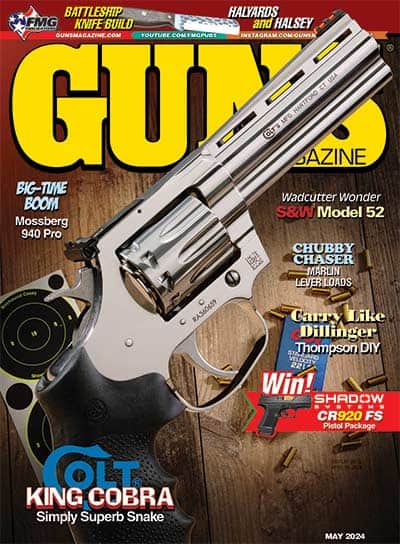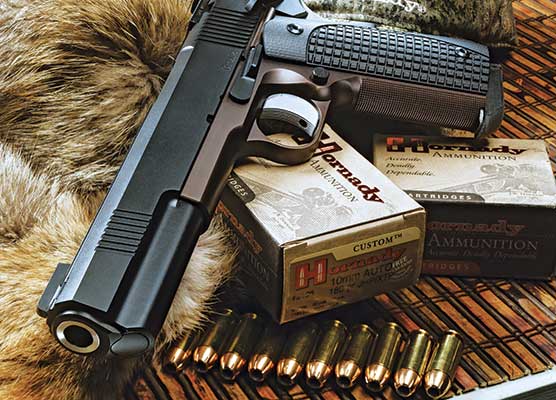My Main Squeeze
Understanding Interlimb Interaction
Of all the issues and concerns that need to be considered if you’re going to be carrying a firearm, especially for self-defense, the one I’d nominate as “Most Likely To Be Ignored” is the idea of “Sympathetic Squeeze.”
And, we aren’t referring to a really understanding romantic partner.
Whether you’re a student or instructor, anytime this idea is brought up in a shooting class the general response is an unspoken look of “Yeah, yeah, right. When do we get to the part where we do backflips and shoot five terrorists, and look fabulous while doing it?!?” For lots of people, sympathetic squeeze is simply a silly myth, like Bigfoot, astrology or alcohol-free beer.
But it ain’t. And it’s an important notion — especially for cops — but even for “Normal Earth People” like you and me. Let me explain.
Reflex Action
If you aren’t familiar, sympathetic squeeze or more technically, “Interlimb Interaction,” is the process whereby one hand involuntarily moves when the other is commanded to do something, typically in times of great stress. It might sound like a parlor trick but it’s real, and if you happen to be holding a gun when it occurs, things can go from humorous to horrible in a split second.
The sympathetic squeeze is a reflex and reflexes come as standard-issued policy for all normal human bodies. They serve a valuable survival function and can sometimes even be entertaining, such as when the doctor uses the little rubber hammer to make your leg flop around.
However, research during the 1990s into law-enforcement shootings of already-subdued criminals made it clear sometimes reflexes can be a bad thing. You might remember several high-profile events where suspects in handcuffs were killed by cops. The cops claimed with never intended to pull the trigger but nobody believed them. Scientists then “discovered” interlimb interaction.
I put quotes about the word discovered because the phenomenon had been well-known for years among physiologists but nobody had ever really applied it to the human endeavor of holding people at gunpoint. Basically, the cops were telling the truth they never meant to shoot the prisoner. However, in the heat of the moment, they did try to open a door, pick up a piece of gear or otherwise engage their non-gun hand. The basic reflex fired (literally) and people died.
And, lest you think this problem is the exclusive domain of cops and CCW holders, consider another hypothetical situation — a group of upland game or duck hunters in a field. As they get back to the truck after a long day of hunting, cold, tired and hurried, someone goes to open the door or tailgate while holding their still-loaded shotgun. You’d better hope their finger isn’t on the trigger and they aren’t unconsciously covering “one of their buddies.” If so, “Houston, we might have a problem.”
Interlimb interaction also has a cousin named “startle response” wherein you tend to clench your hands if you are badly startled or lose your balance. It doesn’t happen every time but there are plenty of bullet holes where there shouldn’t be because people weren’t minding their safety rules when a loud noise happened or they tripped.
Way Back When
Years ago, I had a memorable instance of sympathetic squeeze, which finally and utterly convinced me this is a serious matter. Things turned out fine and even a bit entertaining but could have been much different.
I was working mid-shift at the cop shop one winter evening. We had chased a stolen car out into the countryside after dark where, as is required by the Official Car Thief Handbook, the suspect crashed and bailed out into a plowed field. He ran some a distance into the stubble and lay down in the mud.
Approximately 10,000 police officers were searching the area and a younger version of Your Matchless Hero volunteered to walk the field in search of our catch of the day. Moving cautiously down the grassy berm of a drainage ditch, I suddenly spied our suspect lying down at the end of my flashlight beam.
At low-ready, I addressed the immobile suspect using highly descriptive terms which I euphemistically described as “Commands” in the police report. In reality, I enthusiastically informed him I would blast his nevermind to Neverland if he made any freelance moves.
The bad guy complied with my threats — I meant “orders” — and immediately stretched out to await handcuffing. But, rather than approach the semi-immobilized suspect, I attempted to use my portable radio to call in the cavalry.
Now at least 20 years after the fact, I have a very clear recollection of being unable to press the transmit button on my radio without causing my trigger finger to simultaneously begin curling from its position alongside the trigger guard of my GLOCK 45. In the slow-motion replay on the widescreen in my brain, I remember being so angry my right finger would not stand still while I was merely trying to push the darn radio button.
For several seconds, a raging battle ensued as I fought to separate the actions of the two digits, yet it seemed both of my index fingers were tied together by an invisible piece of twine.
If the suspect had been aware of my predicament, he might have had time to sneak off into the darkness or press an attack. If nothing else, he missed a good laugh as I was locked in the proverbial mental quandary of not knowing whether to “go potty” or go blind.
Fortunately, the thundering herd was nearby and soon joined me. We took our little mud-covered buddy into custody and no one was the wiser. However, I knew for the space of five to 10 seconds I was entirely incapable of organized reaction during this critical moment.
This totally insignificant incident remains so memorable because of the profound shock I experienced upon realizing my finger kept closing on the trigger without authorization. I’m absolutely sure if I had been forced to fire my pistol, I would have also transmitted on the radio at the same time.
The moral of the story is simple — sympathetic squeeze is real and it happens. Even to you.
The simplest fix for the problem is to simply to keep doing what we already do: trigger finger off the trigger and held straight unless actually firing. Have you noticed those scrunchy little pads on the frame above the trigger on most striker-fired 9mm pistols? They’re there for a reason — they’re intended as a little backstage area for your trigger finger to hang out until showtime.
Stop Pointing
If you hadn’t worked it out, interlimb interaction is the reason we never, ever, never “hold someone at gunpoint.” Cops used to do this every day of the year but the discovery of our old friend sympathetic squeeze put an end to the practice. Now, if a cop is holding someone at gunpoint, the suspect had darn better be a candidate for immediate application of deadly force. Same rational goes for CCW holders.
This is why using a low-ready position is important. It allows you to clearly see the suspect’s hands yet allows nearly instantaneous firing if a problem suddenly develops. Most importantly, it builds in a small margin of error if something untoward, such as interlimb interaction, a startle response or simple spontaneous brain flatulence, occurs.
When you consider sympathetic squeeze (and the startle response, and a zillion other things), it turns out Col. Jeff Cooper was pretty smart when he codified the four basic gun-handling rules. If you follow the rules to the letter, at least two separate-but-concurrent violations must occur in order for a tragedy to happen. This is why keeping a straight trigger finger until the sights are on target and not pointing at anything you don’t expressly intend to destroy — such as a captured criminal — are so important.
This whole discussion might seem like a minor academic point and something you won’t need to worry about, but in today’s political climate, using deadly force against someone who doesn’t clearly warrant such treatment will cause grievous repercussions for you.
If you avoid shooting people or things you don’t intend to shoot, it vastly increases the odds you’ll always have the opportunity to go home and give your Significant Other a good squeeze — using both hands!



